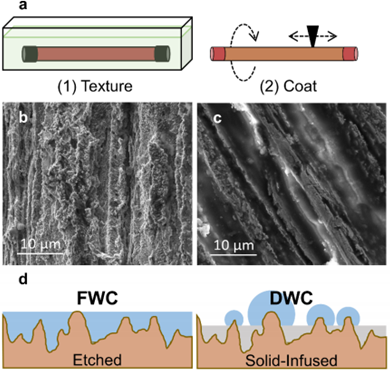THE CHALLENGE
Thermoelectric power plants are significant water consumers, with estimates of up to 49% of total U.S. water use being attributed to them. As water resources become more precious due to climate change and population growth, steam condensation in power generation must adapt and become more efficient. Efficiency improvements to power plant condensers, most of which are once-through heat exchangers, could provide substantial environmental and economic benefits.
OUR SOLUTION
Researchers in Ranga Pitchumani’s Advanced Materials and Technologies lab at Virginia Tech have developed a novel two-step technique for fabricating solid-infused surfaces (SIS) with very high condensation heat transfer efficiencies. The new materials are created by first texturing metallic substrates and then infusing them with a specialized polymer. The resulting hybrid surfaces feature condensation heat transfer coefficients that are five times the state-of-the-art currently deployed in existing power plants, with heat transfer effectiveness improvements of 30% over state-of-the-art practice. As an added benefit, the surfaces also provide excellent fouling resistance for an overall improvement in condenser efficiency and dramatic reduction in water usage.

Figure : A) Schematic of two-step texture and coat fabrication process. B) Micrograph of textured metal surface. C) Micrograph of SIS. D) Schematic of film-wise condensation (FWC) on untreated surface versus dropwise condensation (DWC) on SIS